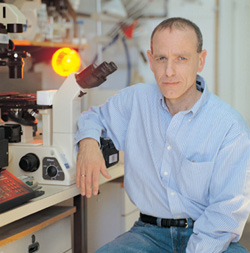It looks like Monday morning rush hour viewed from high above. Hundreds of tiny dots are scurrying down the screen while a parallel fleet heads north. Every once in a while, one of these bright spots stops in its tracks, turns left or right, and subsequently disappears from view.
It's not a traffic update, but an image captured by a system that simulates blood vessel functioning. This type of video footage is increasingly shedding new light on the traffic-law-like mechanisms governing immune cell behavior. Developed by a team headed by Dr. Ronen Alon of the Weizmann Institute's Immunology Department, this modeling system is made up of cells coupled with sophisticated imaging and data processing machinery.
"By building blood vessels from scratch outside the body, we essentially construct a highly controlled and selective environment for examining how key circulatory players interact," Ronen explains. "We're focusing our efforts on one of the most mysterious processes in immunology - how immune cells squeeze through blood vessels on their way to fight infection."
Every minute, millions of white blood cells, the immune system's "soldiers, "leave the circulatory vessels to patrol body tissues, looking for signs of infection or injury. They respond to special "stop-sign"molecules displayed on blood vessel walls.
Unfortunately, this efficient system is exploited by cancerous cells, which also migrate through the blood, metastasizing in distant parts of the body. The cancer cells are able to identify and respond to the stop-sign molecules, gaining access to neighboring tissue. Identifying these signaling molecules and understanding how they function may therefore yield a powerful tool for controlling the immune system and blocking the spread of metastatic cancer cells.
In responding to a signal from infected tissue, a migrating immune cell first rolls to a halt and begins to flatten on the blood vessel wall. It must then squeeze through the layer of endothelial cells that make up that wall. Using their modeling system, Alon's team, which included graduate student Guy Cinamon and Dr. Vera Shinder of the Institute's Electron Microscopy Unit, has now revealed how stop-sign molecules, called chemokines, control this process.
Arriving from neighboring tissues, chemokines enter the circulatory system, where they display themselves on the vessel wall. Each chemokine flags down a different type of immune cell, using cell-specific "passwords" to recruit the cell best suited to the immune task at hand, similar to the way a traffic policeman would call in an ambulance, fire engine, or tow truck, according to need. The team's study, published in Nature Immunology, shows that chemokines also provide directions into the tissue, guiding the immune cell along its short migratory route, from the time it slows down and stops on the blood vessel wall until its point of exit.
To their surprise, however, the team discovered in subsequent experiments that the chemokine signal is not in itself enough for cell migration to occur. It turns out that even if the right chemical signals are present, the immune cells won't exit the blood vessel unless they sense certain mechanical factors inherent to blood flow.
This finding challenges the traditional perception of blood flow. While pausing on the vessel wall, immune cells are continuously exposed to blood flow, which threatens to carry them away from the exit site, much like a stone is swept along a riverbed. But this new study demonstrates, for the first time, that blood flow actually plays a vital role in helping them across vessel walls: When flow is absent in the model system, the immune cells remain "stuck"at the exit site for a short while, after which they return to the circulatory system.
These new insights into cell migration from the circulatory system may contribute to future therapies that fine-tune migration processes - enhancing beneficial immune responses while blocking undesirable migration, such as that of cancerous cells.
Dr. Alon's research is supported by the Abisch Frenkel Foundation for the Promotion of the Life Sciences, Switzerland. He holds the Tauro Career Development Chair in Biomedical Research.
